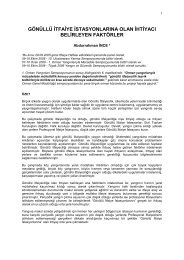buradan - Yangın
buradan - Yangın
buradan - Yangın
You also want an ePaper? Increase the reach of your titles
YUMPU automatically turns print PDFs into web optimized ePapers that Google loves.
TÜYAK BİLDİRİLER KİTABI<br />
2009 PROCEEDINGS BOOK<br />
2<br />
InTEgRATIon – JusT AnoThER Buzz WoRD oR An InTELLIgEnT<br />
soLuTIon To FIRE sAFETY?<br />
John Paul BATEson<br />
Honeywell<br />
Abstract<br />
Life safety systems have typically been interfaced into other<br />
building systems by means of simple relays and inputs. This<br />
session will address whether integrating intelligently through the<br />
use of software really can increase the level of cover afforded for<br />
life and property, whilst at the same time, afford increased levels of<br />
security and protection from terrorist attack.<br />
The vast majority of buildings and sites have a number of systems<br />
that operate independently of each other: fire alarm detection,<br />
intrusion, closed circuit television (CCTV), access control, heating,<br />
lighting, ventilation and air conditioning. All of these functions<br />
could be deemed to be the core sensing and control components<br />
of today’s buildings. Whilst effective in their own right, the ability to<br />
integrate these systems raises the question of whether they are as<br />
effective as they could be and indeed should be. This session will<br />
also address this question.<br />
Entegrasyon – Bir Diğer Moda Terim mi Yoksa<br />
<strong>Yangın</strong> Güvenliği Konusunda Akıllı Bir Çözüm<br />
mü?<br />
Özet<br />
Can güvenliği (yangın, gaz algılama ve uyarı vb) sistemleri,<br />
genellikle binalardaki diğer sistemlerle, röle ve izleme modülleri<br />
kullanılarak entegre edilmektedirler. Bu bildiri, yazılım bazında<br />
gerçekleştirilen akıllı entegrasyon uygulamalarının, can ve mal<br />
güvenliğinin korunma seviyesini arttırırken aynı zamanda düzeyi<br />
arttırılmış bir güvenlik sistemine ve terörist saldırılara karşı<br />
daha korunaklı bir yapıya olanak verip veremeyecekleri üzerinde<br />
durulacaktır.<br />
Bina ve tesislerin büyük çoğunluğunda, birbirlerinden bağımsız<br />
olarak çalışan bir çok sistem mevcuttur: <strong>Yangın</strong> algılama ve ihbar,<br />
hırsız alarm, kapalı devre televizyon (CCTV), kartlı geçiş, ısıtma,<br />
aydınlatma, havalandırma ve iklimlendirme sistemleri gibi. Tüm bu<br />
işlevler, günümüz binalarının temel algılama ve kontrol bileşenleri<br />
olarak varsayılabilir. Her ne kadar kendi başlarına belli bir<br />
verimliliğe sahip olsalar da, bu sistemleri birbirleri arasında entegre<br />
edebilme olanağı, ne kadar etkin oldukları ve aslında ne kadar<br />
etkin olabilecekleri konusunda bir soruyu gündeme getirmektedir.<br />
Bu bildiride aynı zamanda bu sorunun da yanıtı aranacaktır.<br />
1. Summary<br />
Integration can be as straight forward as linking multiple systems<br />
together with something as simple as a relay, but this begs the<br />
TÜYAK 2009<br />
question of whether this does the term<br />
‘integration’ any justice. In addition,<br />
what protection of life and property<br />
does this method of connectivity bring<br />
in comparison to that of a truly intelligent<br />
approach to building integration? This is<br />
considered below with regards to a fire<br />
scenario, using a partially integrated<br />
approach and a smart alternative.<br />
1.1. Fire scenario: A partially integrated approach<br />
When a fire system activates, alarms sound, certain doors close to<br />
help contain the possible fire and others open to allow occupants<br />
out of the building. There may be a link to a Building Management<br />
System (BMS) that shuts down air conditioning and intake into the<br />
building. It all seems straightforward enough on the surface and is<br />
quite typical of a great many installations in use today. However,<br />
it is important to look at what is actually happening beneath the<br />
surface.<br />
The fire alarm control panel will, if it is capable, identify the point<br />
source of the activation. If the system is monitored, the Fire Brigade<br />
will be called. In most cases, the occupants will be required to file<br />
out of the building in accordance with the evacuation plan.<br />
With regards to how the building/facility managers know whether a<br />
genuine fire has caused the activation or a false alarm, the answer<br />
is that they don’t. Unless someone is tasked with investigating the<br />
activation, there is no way of telling. This means that the Brigade<br />
will be called out to attend yet another unwanted activation. Some<br />
might argue it is better that they attend than not at all. However, it<br />
would be preferred if they only came when actually needed. The<br />
human nose may be a good ‘detector’, but do we really need to<br />
burn the nose to spite the system?<br />
Assuming the fire alarm system has operated as intended and<br />
the occupants are now evacuating the building through the doors<br />
that have now failed safe, allowing them to escape, the very same<br />
doors that are letting people out are also letting people in. With<br />
regards to how do the building/facility managers know that the<br />
system hasn’t been maliciously activated to provide thieves with an<br />
opportunity to take the laptops that have been left behind, again,<br />
the answer is they don’t. The person who is checking to see if the<br />
fire is genuine can’t be replied upon to stop them. This scenario<br />
raises the question of whether building/facility managers can be<br />
selective about how the security systems operate in the event of<br />
a fire condition.





